The Moza RS V2 in a nutshell
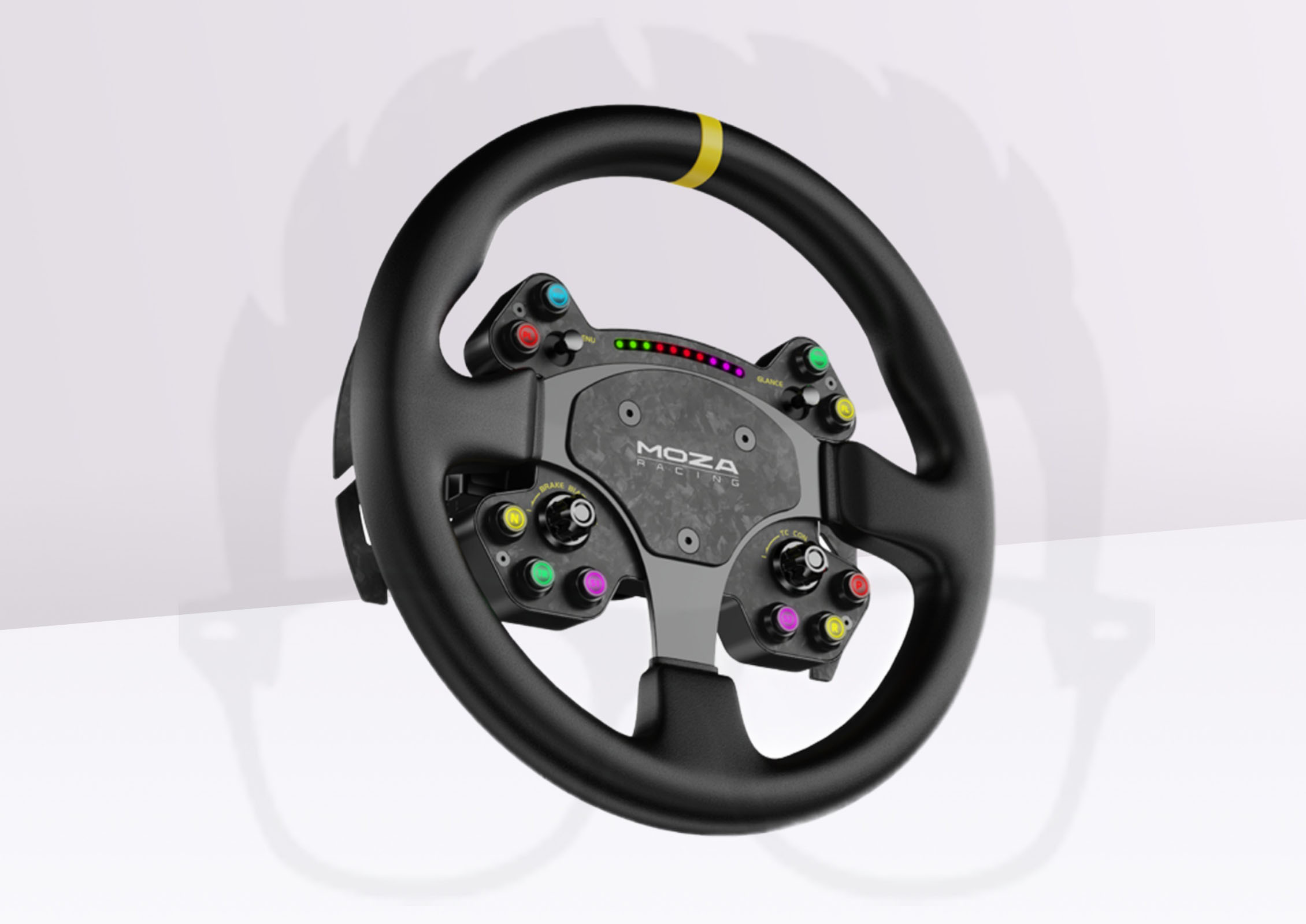
Advantages & Disadvantages
✅ Aluminum frame with forged carbon-fiber faceplate and button module
✅ Backlit buttons
✅ A leather wheel surround
✅ 4 rear paddles
❌ Lack of screen on steering wheel
ㅤ
Since the launch of its very first sim-racing products, the brand Moza Racing brand has made a name for itself in the industry by offering good, affordable peripherals that compete with the big boys. It must be said that this has been no mean feat, for the simple reason that it’s hard to compete with a manufacturer that has been present in the segment for over 20 years.
Nevertheless, Moza has banked on the wow effect of its products, on its innovations and also, I must admit, on its sometimes very aggressive pricing. And all this has paid off, as in the space of just 3 years, the Chinese manufacturer has become a serious player in the industry, with an ever-growing fane-base.
Admittedly, Moza’s catalog pales in comparison to that of Fanatec for example, but the Chinese brand has what it takes, and where it takes it. For example, Moza offers 6 Direct Drive bases, ranging from 3.9 nm to 21 nm torque. For flywheels, it’s exactly the same number of entries, with, for example, the RS V2 which is a rather high-end wheel with a carbon fiber finish. In what follows, I’ll introduce it, tell you about its strong points and give you my opinion on it.
Main and technical characteristics of the wheel
- Aluminum steering wheel structure and back-plate
- Faceplate, paddles and button modules in forged carbon fiber
- 10 backlit mechanical buttons, 2 funky switches and 2 encoders
- 4 magnetic rear paddles
- Leather finish all around the steering wheel
- PC-compatible on bases from R5 to R21
- 33 cm diameter wheel
RS V2 design
As with any sim-racing product presentation, let’s start with the design. The RS V2 is a premium version of a steering wheel already in Moza’s range, the CS V2. For the RS, the manufacturer of sim-racing peripherals has chosen to use more noble materials, notably carbon fiber on certain parts of the steering wheel.
As a result, we end up with a forged carbon-fiber faceplate, button module and paddles to great effect, enhanced by a yellow band on the top of the steering wheel. It’s a real beauty as far as I’m concerned, even if this steering wheel costs almost twice as much as the one it’s based on. But hey, it’s got more controls, a premium design and more noble materials, so I say the price is justified.
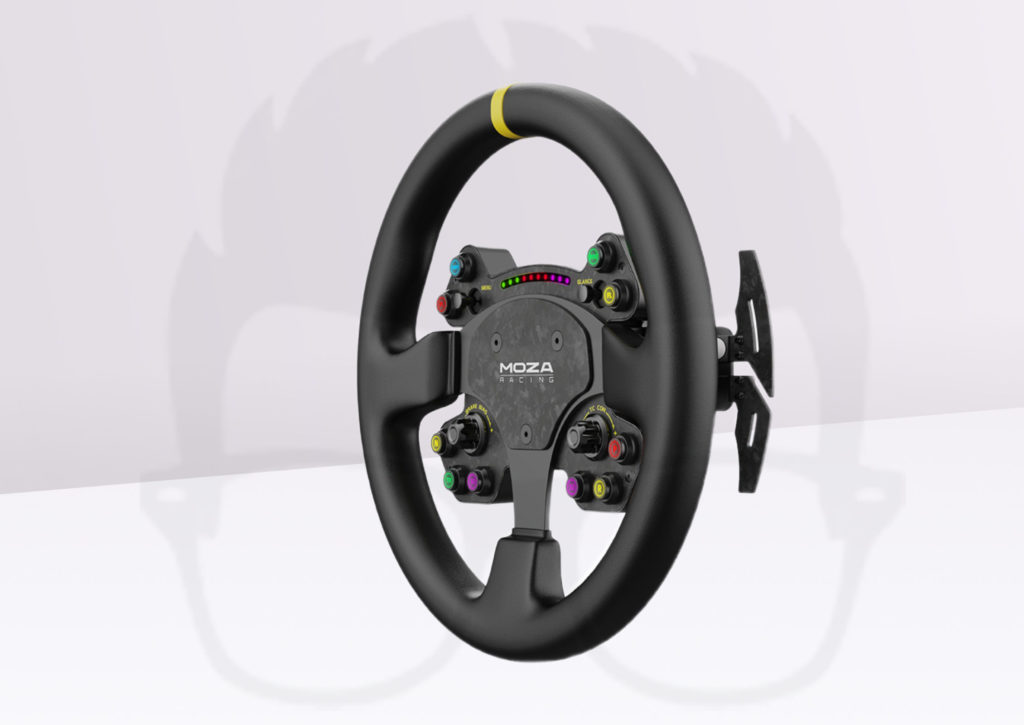
Customized assembly
Moza’s QR is located at the rear of the RS V2, on an aluminum back-plate to ensure rigidity. To install this steering wheel on one of the compatible bases (from the R5 to the R21), simply pull the ring on the QR D1-Spec, align the steering wheel with the base, install the steering wheel and release the ring.
Moza’s QR allows excellent attachment of the flywheel to the base drive shaft, without flexing or anything else. It’s one of the best currently available on the sim-racing market.
Manufacturing and finishing
As I said earlier, Moza has used more noble materials on the RS V2, as opposed to synthetic leather and aluminum on the CS version. Forged carbon fiber is used on the faceplate, as well as on the button module and paddles. This material is just superb, very well finished and ultra-premium, I must say. To my knowledge, few sim-racing manufacturers use this material, and it’s great that Moza is one of them.
As for the finish, it’s top-notch, nothing to say about that. All the parts fit together superbly, with no visible gaps. The leather around the steering wheel is top-notch, most certainly a product of the automotive industry. Even though the RS V2 is a version based on the CS V2, you can feel and see the upmarket character of this steering wheel.
Handling the wheel
The steering wheel is 33 cm (13 inches) in diameter, yet completely round. This makes it perfect for many sim-racing disciplines, such as rallying, GT, NASCAR, etc. The ergonomics of this steering wheel are excellent, as all the buttons, except perhaps 2, are very close to your hands, on the sides of the faceplate.
The buttons are mechanical and backlit, making them easy to use on the fly. The funky switches and encoders are also easy to use on the fly.
At the rear, we have 4 magnetic paddles on the RS V2, large and well away from the steering wheel. These fall nicely under your fingers, but can sometimes be a little noisy. Fortunately, Moza offers pads to reduce paddle noise, and these are included in the steering wheel package.
Overall, the RS V2’s grip is very good, while its weight is fairly contained, although I personally wouldn’t use this steering wheel with an R5 base for clipping reasons.
Sensations during play
As I’ve mentioned several times, this wheel is compatible with all the bases offered by Moza Racing, from the R5 to the R21. Personally, I wouldn’t use this wheel with an R5, or even an R9 in some cases, and the reason is clipping. The steering wheel is rather large at 33 cm in diameter, and Moza’s small chainstays aren’t really designed to take such a heavy load, despite the fact that the RS V2 doesn’t weigh all that much.
Nonetheless, in terms of feel, you’re superbly well served with a steering wheel that grips beautifully no matter what title you’re racing. On titles like AC or ACC, using the RS V2 in GT, for example, is a killer. Feedback is superbly well reproduced, provided you’ve got a good base too(R12 and up). The mass of the steering wheel is rather well contained thanks to the use of forged carbon fiber, even if there isn’t much of it, I must admit.
The addition of extra buttons allows this steering wheel to open up to a wide range of virtual car competitions, and this has an impact on your lap times. With the RS V2, I noticed shorter lap times than with the CS VS, which on paper is the same steering wheel.
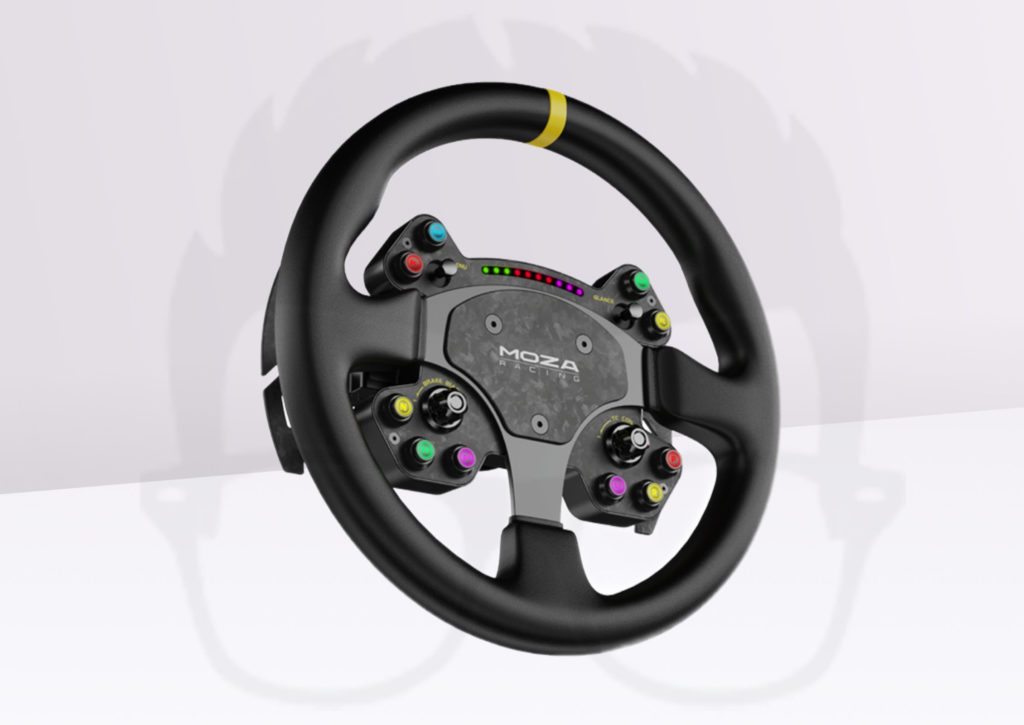
RS V2 steering wheel compatibility
As already mentioned, the RS V2 is compatible with all Moza Racing bases: R5, R9, R12, R16 and R21. For a virtual driver looking for a good wheel, this is just perfect, as the RS V2 is usable with all Moza peripherals.
As far as sim-racing titles and platforms are concerned, this steering wheel can be used on virtually all those available on PC without the slightest problem.
Value for money
Priced at €469, the RS V2’s value for money is excellent, even if this steering wheel doesn’t have all the bling-bling options of its competitors like a screen, flat bottom, etc. Honestly, you’ll be hard-pressed to find anything better at this price, especially with a steering wheel that uses forged carbon fiber. The only downside is that this steering wheel is sometimes out of stock, and you’ll have to do a bit of searching to find it online.
My verdict on the RS V2 wheel from Moza Racing
What more can we say about the RS V2? Except to go out and buy it if you’re looking for an excellent steering wheel that does practically everything. The price is right in my opinion, and the feel is very good, provided you pair it with a base that’s over 10nm(R12, R16 and R21). The design is beautifully minimalist, and the build quality is top-notch.
True, the RS V2 doesn’t have a faceplate screen, but that’s the case with virtually all Moza steering wheels, except the FSR, which is the brand’s top dog. Nevertheless, the RS V2 remains an excellent option that I highly recommend.

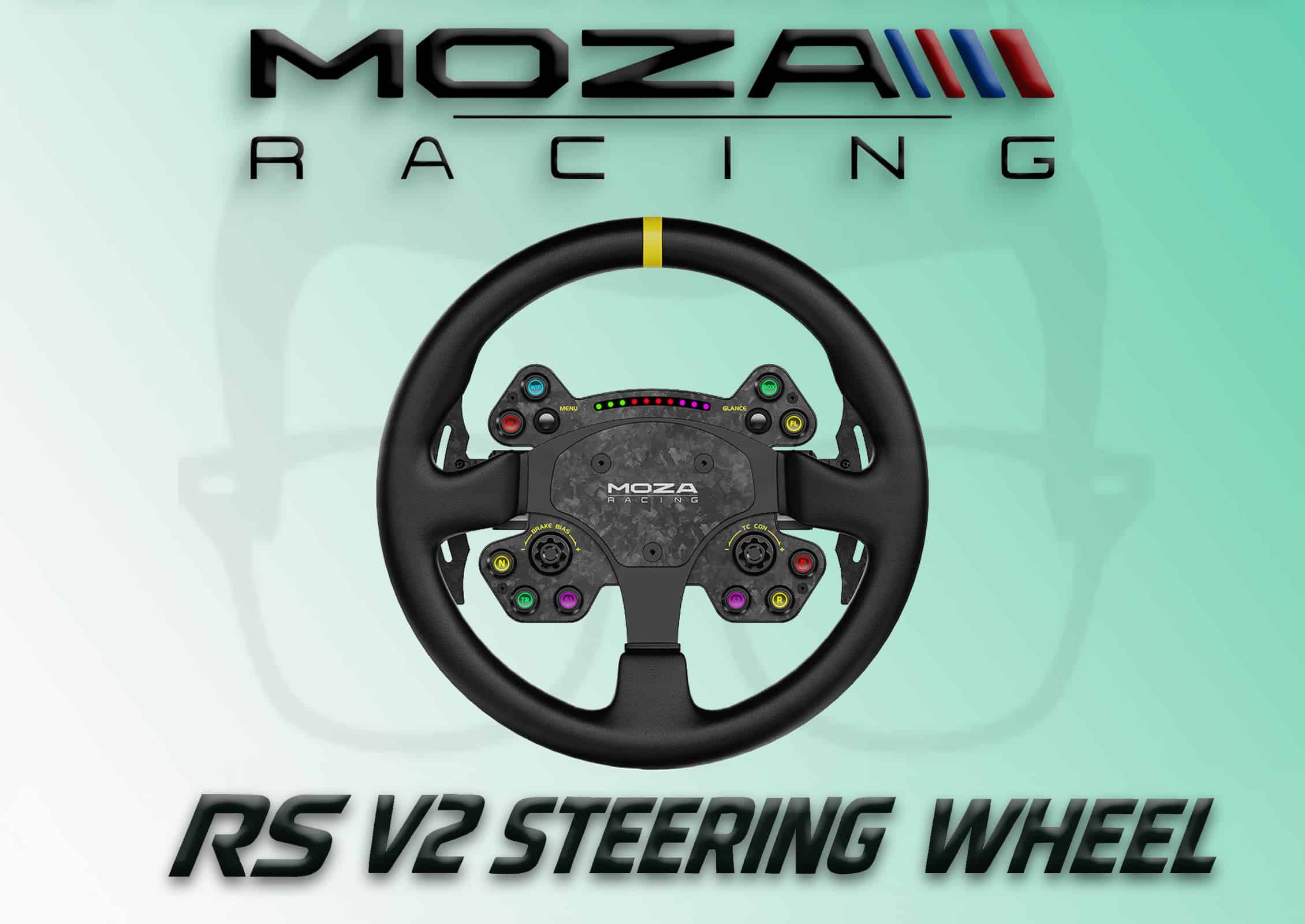

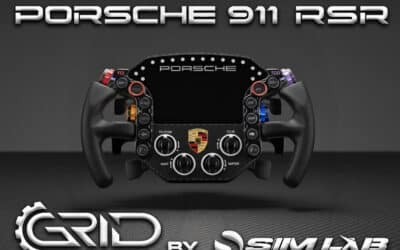

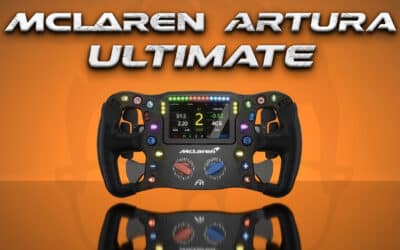
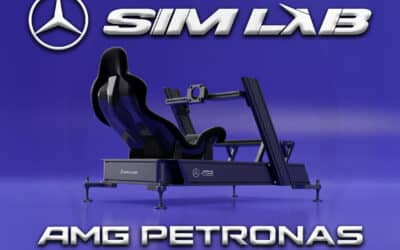
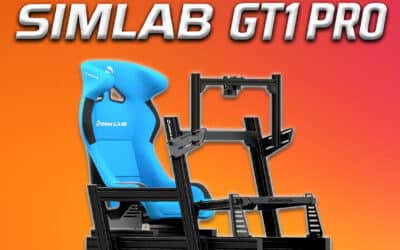
0 Comments